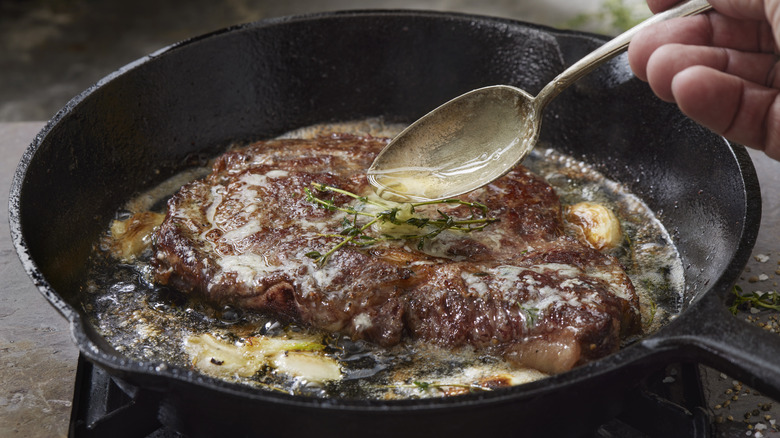Why The Timing Of Adding Butter To Steak Changes Everything
Mastering the art of cooking steak takes some trial and error, but one crucial detail can make a surprisingly huge difference: the timing of when you add butter. However, the best time to add butter depends on how you incorporate it. The earliest you should introduce it is about midway through preparation or when the steak has just a few minutes of cooking time left. Any sooner and too much moisture will be present, preventing the steak from attaining a golden brown sear through the Maillard Reaction. To achieve this golden crust, steak needs to be cooked above 400 Fahrenheit, and butter's smoke point (where it starts to burn) is closer to 300 degrees Fahrenheit.
To avoid a bitter or burnt butter taste (and to get a little fat on your pan) try starting with a canola or peanut oil instead, which boast smoke points over 400 Fahrenheit. By waiting to add butter to the pan, you give the steak time to develop a crust, and though the butter might brown, it shouldn't burn. Try using cold butter since it takes longer to melt. For a full-bodied flavor, baste the butter on your steak when the center is 20 or so degrees from your ideal temperature.
Alternatively, you can let the butter melt onto the steak after removing it from the heat. While the meat rests, it soaks in the butter for a rich, concentrated taste. Because the butter melts slowly, it makes for a lovely finishing touch. Cold butter also helps cool the steak slightly as it rests, preventing overcooking. This is ideal for those who love a perfectly cooked medium or rare steak. Each method brings unique benefits to the table, but the key takeaway is the same: Timing is everything.
The kind of butter you use can transform a steak's flavor profile
While it's important to avoid seasoning mistakes such as using the wrong kind of salt and not patting the meat dry, don't forget to take the time to flavor your steak's butter. Before enhancing it with herbs and aromatics, start by choosing the right kind of butter. If you plan to add butter earlier in the cooking process, ghee (a clarified butter with a higher smoke point) is a solid option. It also adds a nutty, earthy finish that gives your steak a well-rounded profile. If you want to be mindful of sodium levels, go for unsalted butter. On the other hand, salted butter works well for a classic finish.
Once you've chosen your butter, you can keep it simple. or take it up a notch by making compound butter by incorporating additional sweet or savory ingredients. Try a garlicky herb butter for a simple yet flavorful choice. Meanwhile, a brown sugar and bourbon butter creates a rich, caramelized flavor, especially when paired with caramelized onions. For a tasty twist, add miso, lemon zest, and freshly ground black pepper to achieve a bright, umami taste. If you're craving something sweet and tangy, a honey and Dijon butter brings a lovely balance. Whatever direction you choose, a well-flavored and well-timed butter can take your steak from great to unforgettable.

